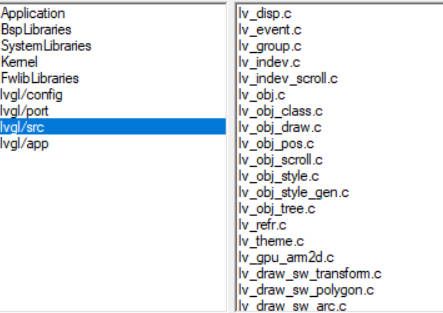LVGL学习 stm32f407-board-lvgl v8.3移植
LVGL学习 stm32f407-board-lvglv8.3移植
移植过程有问题,请参考正点原子的教程或者视频
硬件平台
LVGL
LVGL(Light and Versatile Graphics Library)是一个免费的开源图形库,提供创建具有易 于使用的图形元素、漂亮的视觉效果和低内存占用的嵌入式 GUI。

LVGL 是一款具有丰富的部件,具备高级图形特性,支持多种输入设备, 多国语言和独立于硬件之外等免费的开源图形库。接下来我们来看一下 LVGL 图形用户库的主要特点:
- 强大的构建块:按钮、图表、列表、滑块、图像等部件。
- 具有高级图形属性:具有动画、抗锯齿、不透明度、平滑滚动的高级图形。
- 支持各种输入设备:如触摸、鼠标、键盘、编码器。
- 支持多语言:UTF-8 编码。
- 支持多显示器:它可以同时使用多个 TFT 或者单色显示器。
- 支持多种样式属性:它具有类 CSS 样式的完全可定制的图形元素。
- 独立于硬件之外:它与任何微控制器或显示器一起使用。
- 可扩展性:它能够以小内存运行(最低 64 kB 闪存,16 kB RAM 的 MCU)。
- 支持操作系统、外部存储器和 GPU(不是必需的)。
- 具有高级图形效果:可进行单帧缓冲区操作。
- 纯 C 编写: C 语言编写以获得最大的兼容性。
移植工作
- 获取LVGL源码
从 LVGL 官方 GitHub 网址(https://github.com/lvgl/lvgl/)下载。

- 把文件中的 lv_conf_template.h 文件名修改成 lv_conf.h 文件名

- .打开 lv_conf.h 文件,修改条件编译指令,如下源码所示。

- 打开 examples 文件夹,除了 porting 文件夹外,用户可以删除其他文件和文件夹

把porting文件夹重新命名为lvgl_driver,并修改文件名称。


- 准备一个裸机工程,其中包括lcd,touch驱动,能正常使用,建立LVGL文件夹。

- 在工程中,创建lvgl/src,lvgl/config/,lvgl/port,lvgl/app

- 添加lvgl源码文件
lvgl/config中主要是lvgl.h lv_conf.h配置文件

lvgl/port中主要是lv_port_disp.c,lv_port_indev.c文件,显示与输入接口文件

lvgl/src中主要是lvgl组件的源代码文件,比较重要,把src文件夹下面的所有的C文件全部添加进去,包括子文件夹下面的,添加比较繁琐。(也可以不用添加全部的,参考正点原子的教程,在这里,我是添加了所有的)
 lvgl/app中主要是lvgl案例演示源代码
lvgl/app中主要是lvgl案例演示源代码

- 添加文件路径(参考正点原子教程,这里有的教程会添加非常的多的路径,但是正点原子的教程没有很多路径,我也是参考的,建议参考正点原子的文件夹架构)
如果使用我的文件结果这样子是可以的编译通过的,不过我在后面应该是修改了一下头文件包含的位置,可能与lvgl源码中的写法不一样,仅供参考。

工程结构如下


- 添加部分相关文件
lvgl 的 1ms 心跳 通过调用定时器3
//==================================================================================================
// 实现功能:定时器3中断服务函数
// 函数说明: TIM3_IRQHandler
// 函数备注:
//--------------------------------------------------------------------------------------------------
// | - | - | 0 | 1 | 2 | 3 | 4 | 5 | 6 | 7 | 8 | 9
//==================================================================================================
void TIM3_IRQHandler(void)
{
if(TIM_GetITStatus(TIM3,TIM_IT_Update)==SET) //溢出中断
{
lv_tick_inc(1);//lvgl的1ms中断
}
TIM_ClearITPendingBit(TIM3,TIM_IT_Update); //清除中断标志位
}
修改disp代码
/**
* @file lv_port_disp_templ.c
*
*/
/*Copy this file as "lv_port_disp.c" and set this value to "1" to enable content*/
#if 1
/*********************
* INCLUDES
*********************/
#include "lv_port_disp.h"
#include 基本上只要修改disp_flush函数,不同的屏幕显示接口移植
修改indev代码,配置好触摸屏驱动
/**
* @file lv_port_indev_templ.c
*
*/
/*Copy this file as "lv_port_indev.c" and set this value to "1" to enable content*/
#if 1
/*********************
* INCLUDES
*********************/
#include "lv_port_indev.h"
#include "../lvgl.h"
#include "touch.h"
/*********************
* DEFINES
*********************/
/**********************
* TYPEDEFS
**********************/
/**********************
* STATIC PROTOTYPES
**********************/
static void touchpad_init(void);
static void touchpad_read(lv_indev_drv_t * indev_drv, lv_indev_data_t * data);
static bool touchpad_is_pressed(void);
static void touchpad_get_xy(lv_coord_t * x, lv_coord_t * y);
/**********************
* STATIC VARIABLES
**********************/
lv_indev_t * indev_touchpad;
static int32_t encoder_diff;
static lv_indev_state_t encoder_state;
/**********************
* MACROS
**********************/
/**********************
* GLOBAL FUNCTIONS
**********************/
void lv_port_indev_init(void)
{
static lv_indev_drv_t indev_drv;
/*------------------
* Touchpad
* -----------------*/
/*Initialize your touchpad if you have*/
touchpad_init();
/*Register a touchpad input device*/
lv_indev_drv_init(&indev_drv);
indev_drv.type = LV_INDEV_TYPE_POINTER;
indev_drv.read_cb = touchpad_read;
indev_touchpad = lv_indev_drv_register(&indev_drv);
/*------------------
* Touchpad
* -----------------*/
/*Initialize your touchpad*/
static void touchpad_init(void)
{
/*Your code comes here*/
tp_dev.init();
if (0 == (tp_dev.touchtype & 0x80))
{
TP_Adjust();
TP_Save_Adjdata();
}
}
/*Will be called by the library to read the touchpad*/
static void touchpad_read(lv_indev_drv_t * indev_drv, lv_indev_data_t * data)
{
static lv_coord_t last_x = 0;
static lv_coord_t last_y = 0;
/*Save the pressed coordinates and the state*/
if(touchpad_is_pressed())
{
touchpad_get_xy(&last_x, &last_y);
data->state = LV_INDEV_STATE_PR;
}
else {
data->state = LV_INDEV_STATE_REL;
}
/*Set the last pressed coordinates*/
data->point.x = last_x;
data->point.y = last_y;
}
/*Return true is the touchpad is pressed*/
static bool touchpad_is_pressed(void)
{
if(tp_dev.sta & TP_PRES_DOWN)
return true;
return false;
}
/*Get the x and y coordinates if the touchpad is pressed*/
static void touchpad_get_xy(lv_coord_t * x, lv_coord_t * y)
{
(*x) = tp_dev.x[0];
(*y) = tp_dev.y[0];
}
#else /*Enable this file at the top*/
/*This dummy typedef exists purely to silence -Wpedantic.*/
typedef int keep_pedantic_happy;
#endif
主函数配置
参考实际工程的东西,这里的许多的头文件包含,全部在main.h中
int main(void)
{
Hareware_Iint();
printf("Hareware_Iint [OK] \r\n");
lv_init(); // lvgl系统初始化
lv_port_disp_init(); // lvgl显示接口初始化,放在lv_init()的后面
lv_port_indev_init(); // lvgl输入接口初始化,放在lv_init()的后面
//lv_example_event_1();
//lv_example_get_started_3();
//lv_example_anim_timeline_1();
//lv_demo_benchmark();
//lv_example_event_3();
//lv_example_chart_5();
//lv_example_list_2();
//lv_example_roller_3();
lv_example_meter_1();
while (1)
{
tp_dev.scan(0);
lv_task_handler(); // lvgl的事务处理
}
}
移植效果
实用工具 | GUI-Guider的使用分享
工具使用教程文章链接
GUI Guider是恩智浦为LVGL开发了一个上位机GUI设计工具,可以通过拖放控件的方式设计LVGL GUI页面,加速GUI的设计。
设计完成的GUI页面可以在PC上仿真运行,确认设计完毕之后可以生成C代码,再整合到MCU项目中。

具体使用以后再说,先看看效果
lv_ui guider_ui;
int main(void)
{
Hareware_Iint();
printf("Hareware_Iint [OK] \r\n");
lv_init(); // lvgl系统初始化
lv_port_disp_init(); // lvgl显示接口初始化,放在lv_init()的后面
lv_port_indev_init(); // lvgl输入接口初始化,放在lv_init()的后面
//lv_example_event_1();
//lv_example_get_started_3();
//lv_example_anim_timeline_1();
//lv_demo_benchmark();
//lv_example_event_3();
//lv_example_chart_5();
//lv_example_list_2();
//lv_example_roller_3();
//lv_example_meter_1();
setup_ui(&guider_ui);
events_init(&guider_ui);
while (1)
{
tp_dev.scan(0);
lv_task_handler(); // lvgl的事务处理
}
}








